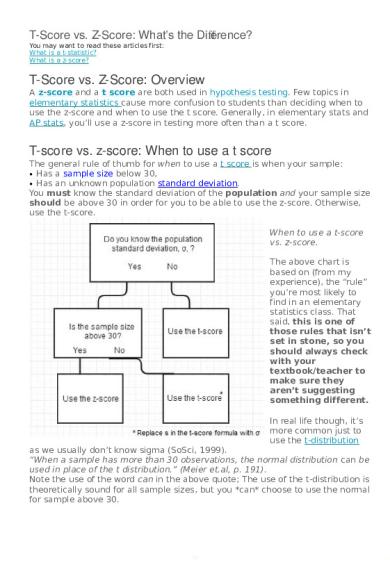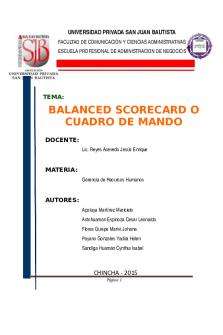T Score Vs Z Score - notes PDF

| Title | T Score Vs Z Score - notes |
|---|---|
| Author | Dr George Varghese |
| Course | Statistics in Psychology |
| Institution | Indira Gandhi National Open University |
| Pages | 3 |
| File Size | 198.7 KB |
| File Type | |
| Total Downloads | 72 |
| Total Views | 146 |
Summary
notes...
Description
TScor ev s .Z Scor e:What ’ st heDi ffer ence ? You may want to read these articles first: What is a t-statistic? What is a z-score?
TScor ev s .ZScor e:Ov er vi ew A z-score and a t score are both used in hypothesis testing. Few topics in elementary statistics cause more confusion to students than deciding when to use the z-score and when to use the t score. Generally, in elementary stats and AP stats, you’ll use a z-score in testing more often than a t score.
Ts cor ev s .z s cor e:Whent ouseats cor e The general rule of thumb for when to use a t score is when your sample: • Has a sample size below 30, • Has an unknown population standard deviation. You must know the standard deviation of the population and your sample size should be above 30 in order for you to be able to use the z-score. Otherwise, use the t-score. When to use a t-score vs. z-score. The above chart is based on (from my experience), the “rule” you’re most likely to find in an elementary statistics class. That said, this is one of those rules that isn’t set in stone, so you should always check with your textbook/teacher to make sure they aren’t suggesting something different. In real life though, it’s more common just to use the t-distribution as we usually don’t know sigma (SoSci, 1999). “When a sample has more than 30 observations, the normal distribution can be used in place of the t distribution.” (Meier et.al, p. 191). Note the use of the word can in the above quote; The use of the t-distribution is theoretically sound for all sample sizes, but you *can* choose to use the normal for sample above 30.
TScor ev s.ZScor e:Zscor e Technically, z-scores are a conversion of individual scores into a standard form. The conversion allows you to more easily compare different data; it is based on your knowledge about the population’s standard deviation and mean. A zscore tells you how many standard deviations from the mean your result is. You can use your knowledge of normal distributions (like the 68 95 and 99.7 rule) or the z-table to determine what percentage of the population will fall below or above your result. The z-score is calculated using the formula: z = (X-μ)/σ
Where: • σ is the population standard deviation and • μ is the population mean. The z-score formula doesn’t say anything about sample size; The rule of thumb applies that your sample size should be above 30 to use it.
TScor ev s.ZScor e:Tscor e Like z-scores, t-scores are also a conversion of individual scores into a standard form. However, t-scores are used when you don’t know the population standard deviation; You make an estimate by using your sample. T = (X – μ) / [ s/√(n) ]. Where: • s is the standard deviation of the sample. If you have a larger sample (over 30), the t-distribution and z-distribution look pretty much the same. Therefore, you can use either. That said, if you know σ, it doesn’t make much sense to use a sample estimate instead of the “real thing”, so just substitute σ into the equation in place of s: T = (X – μ) / [ σ/√(n) ]. This makes the equation identical to the one for the z-score; the only difference is you’re looking up the result in the T table, not the Z-table. For sample sizes over 30, you’ll get the same result....
Similar Free PDFs

T Score Vs Z Score - notes
- 3 Pages

Scheefverdeling en z-score
- 2 Pages

Percentile to z score procedure
- 3 Pages

BALLARD SCORE
- 11 Pages

APGAR SCORE
- 6 Pages

SCORE DOWN
- 2 Pages

WIAT–III Score Report
- 8 Pages

EREV SHEL Shoshanim - Score
- 8 Pages

Amazon balanced score card
- 3 Pages

Ballard Score scoresheet
- 1 Pages

Cadenze - Score copia 2
- 2 Pages

Balanced Score Card
- 24 Pages

Ballard Score PRACTICE WORKSHEET
- 1 Pages
Popular Institutions
- Tinajero National High School - Annex
- Politeknik Caltex Riau
- Yokohama City University
- SGT University
- University of Al-Qadisiyah
- Divine Word College of Vigan
- Techniek College Rotterdam
- Universidade de Santiago
- Universiti Teknologi MARA Cawangan Johor Kampus Pasir Gudang
- Poltekkes Kemenkes Yogyakarta
- Baguio City National High School
- Colegio san marcos
- preparatoria uno
- Centro de Bachillerato Tecnológico Industrial y de Servicios No. 107
- Dalian Maritime University
- Quang Trung Secondary School
- Colegio Tecnológico en Informática
- Corporación Regional de Educación Superior
- Grupo CEDVA
- Dar Al Uloom University
- Centro de Estudios Preuniversitarios de la Universidad Nacional de Ingeniería
- 上智大学
- Aakash International School, Nuna Majara
- San Felipe Neri Catholic School
- Kang Chiao International School - New Taipei City
- Misamis Occidental National High School
- Institución Educativa Escuela Normal Juan Ladrilleros
- Kolehiyo ng Pantukan
- Batanes State College
- Instituto Continental
- Sekolah Menengah Kejuruan Kesehatan Kaltara (Tarakan)
- Colegio de La Inmaculada Concepcion - Cebu


